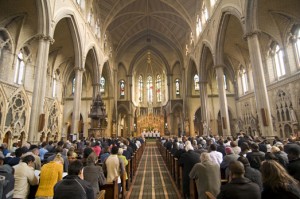Traditionalism and Being “Pastoral”
In your previous letter, you outlined your concern about in whether traditionally minded priests can actually govern in the American Church. I have delayed in responding (and still respond reluctantly) because I’m not really sure what exactly you are looking for.
For every case of a “traditional” priest behaving autocratically, can we not find just as many instances of autocrats looking to destroy traditional church architecture and practice? Shouldn’t they have to govern with this in mind as well? Is it only worth talking about if a parish attempts to move in a more traditional direction?
Being a layman, I’m reluctant to give priests any advice for how they will run their own congregations. I can only say they should listen to the mind of the Church, and carry out reform where it is feasible, and constantly check to make sure it is feasible. While we should always take into account the pastoral needs of the faithful, the last thing we should want is a democratic veto of a motivated group of parishioners who hinder Catholicism in their parish.
When making these decisions, priests should have in mind not only the pastoral realities of the present flock, but the long-term health of the Catholic community in that area. While funds are limited and you may have to proceed at a glacial pace, continuing current trends of Church architecture is an almost certain way to make sure your Church is not repopulated. Studies have revealed time and time again even young Catholics who are not viewed “traditionalist” view more traditionally-styled architecture a major draw for them in choosing a church. Should their needs be ignored because of an older and graying congregation who fights tooth and nail to keep things in the round or to use ugly felt banners?
When one looks at the Sacred Scriptures, one sees an equal emphasis on the long-term reform and redemption of Israel, combined with demands for an immediate change on many things. (One need only look at Ezra or Nehemiah for examples.) When asking that one mass have an organ instead of a guitar, that two EMHC’s instead of 10 be used, or when asking that those serving the altar be dressed in their Sunday best (or even better, with actual vestments of altar servers!), are these really that radical of proposals?
None of this ignores the duty of the priest to be not only be practical, but to take sufficient time to educate his flock on the changes. A lot of Catholics are ambivalent about high liturgical matters, and often end up supporting changes when they are actually explained. Perhaps if priests took six months of catechesis and explanation before proposing such changes, things would go better.
Also worth mentioning in these discussions are the Bishops. When a priest makes a decision to move in a more traditionally-minded direction, how often do the bishops have their back? Are those of a more traditional bent explaining matters properly? When they assigned a reform-minded priest to an area in need of reform, should they really be so shocked a priest wanted reform? Should not their responsibility be discussed as well?
In the end, I think your article offers far more questions than it does answers. While there is a need for priests to govern with the reality of their congregation in mind, should we not also ask you what should be done with small minorities who seek to hold hostage churches to cater to an agenda increasingly dated?


